Last Tuesday night, my 6-year-old nephew was having a complete meltdown about bedtime. Nothing worked – not bribes, not threats, not even his favorite stuffed animal. Then I started telling him about this mischievous kid named Krishna who used to steal butter from his neighbors. By the third story, he was giggling and asking for “just one more.” That’s when it hit me – these ancient stories still have this incredible power to connect with kids today.
According to Tell-a-Tale’s research on children’s mythology preferences, “Kids love him and grown-ups adore him, in whatever form he is worshiped, be it an infant eating butter, a young boy playing the flute with Radha – the love of his life, or in his larger-than-life avatar giving a discourse to Arjun on the battlefield at Kurukshetra.”
I’ve seen this same magic happen with my own kids and their friends. There’s something about Krishna that just clicks with children – maybe it’s because he’s both incredibly powerful and totally relatable. He gets in trouble for stealing snacks (what kid can’t relate to that?), but he also stands up to bullies and protects his friends.
These aren’t just old stories gathering dust in some temple library. They’re like having a wise friend who can help your kids navigate everything from playground drama to environmental responsibility, all wrapped up in adventures that actually hold their attention.
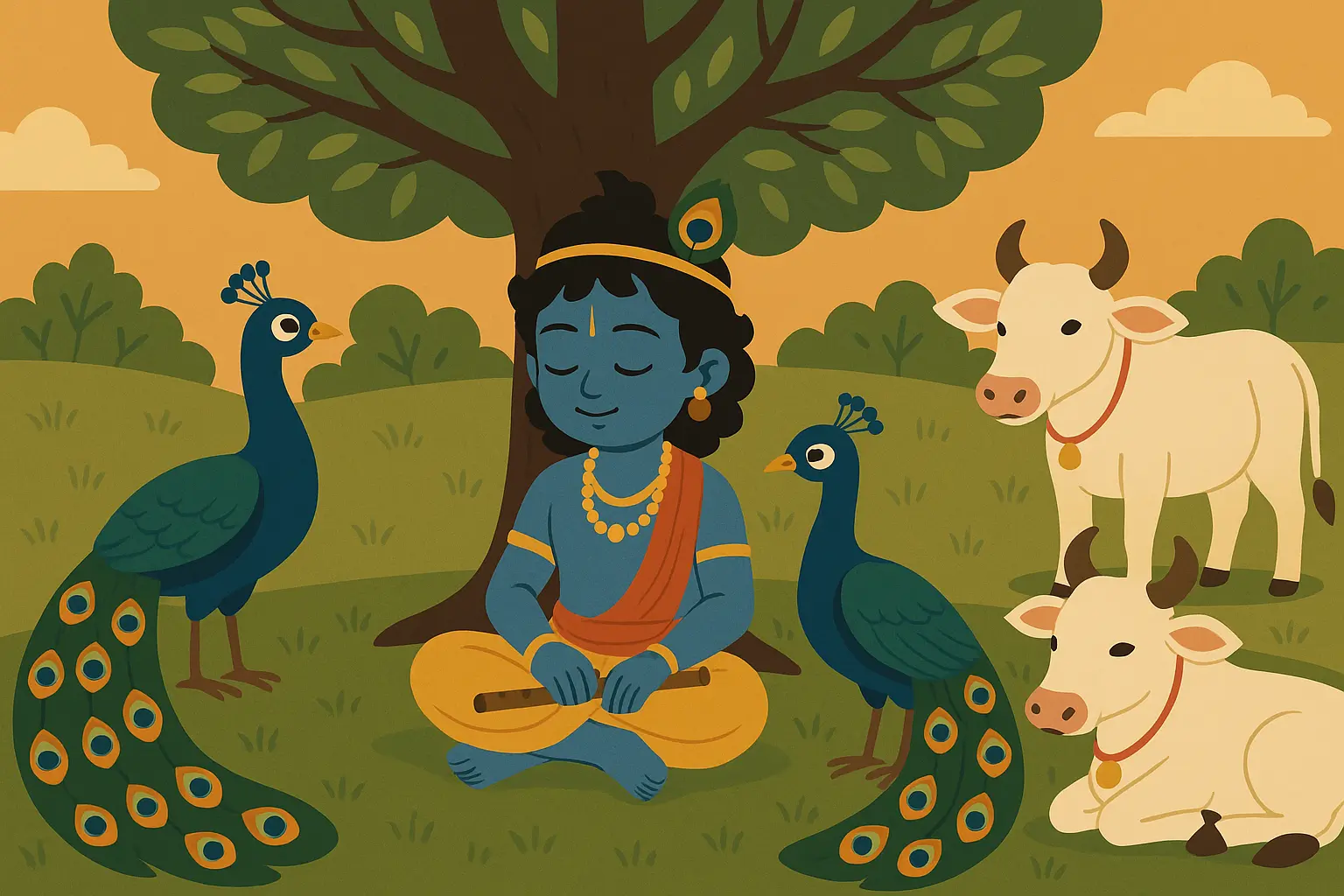
What Makes These Stories Actually Work with Real Kids
Here’s what I’ve noticed after years of telling these stories: kids gravitate toward Krishna because he’s not some distant, perfect figure lecturing them about being good. He’s mischievous, funny, and sometimes gets in trouble – but when it really matters, he always does the right thing.
Think about it – most kids’ heroes are either completely fictional (superheroes) or totally unrealistic (perfect princes and princesses). Krishna is different. He’s got divine powers, sure, but he uses them to solve problems that kids actually face: dealing with bullies, figuring out right from wrong, navigating friendships, and protecting the people he cares about.
Similar to how our collection of bedtime stories for kids combines entertainment with valuable lessons, Krishna tales work on multiple levels simultaneously.
My friend Sarah teaches kindergarten, and she puts it perfectly: “These stories work because they’re honest about how hard it can be to do the right thing. Krishna isn’t some perfect kid who never messes up – he’s real and sometimes gets in trouble. Kids see themselves in that.”
The magic happens on different levels. On the surface, you’ve got exciting adventures – mountain lifting, serpent dancing, magical transformations. Kids love that stuff. But underneath, there are real lessons about courage, friendship, honesty, and standing up for what’s right. The best part? Kids absorb these lessons without feeling like they’re being lectured.
What really sets these stories apart is how they handle complex topics. Instead of telling kids “be brave,” they show Krishna facing down a giant serpent to save his community. Instead of preaching “share with others,” they tell about how Krishna’s generosity with stolen butter actually helped hungry animals and poor kids.
How to Pick the Right Story for Your Kid
Know What Your Kid Can Handle
Look, I’ll be real with you – not every Krishna story works for every age. I learned this the hard way when I tried telling the cosmic vision story to my 5-year-old. Too weird, too much. She just stared at me like I’d lost my mind.
Kids aged 4-7 do best with straightforward stories where you can see what’s happening. The butter thief adventures? Perfect. Simple heroic stuff like protecting animals? Great. Save the deep philosophical discussions for later.
My friend Jen teaches third grade, and she’s got this figured out. She starts her year with “The Butter Thief” because it’s basically a heist story that kids love, but it teaches about consequences and sharing. When she tried jumping straight into the Bhagavad Gita with the same group, they tuned out completely.
Kids aged 8-12 can handle more complex stuff. They’re ready for stories that make them think about the “why” behind actions, not just the “what.” They can appreciate the strategic thinking behind Krishna’s choices and start applying these ideas to their own lives.
Match the Story to What’s Happening
The best time to tell a Krishna story is when your kid is actually dealing with something similar. Got a friendship drama at school? Perfect time for the Sudama story. Dealing with a bully? Bring out the Govardhan Hill tale.
I remember when my daughter was going through a lying phase (every parent knows this one). Instead of lecturing her about honesty, I told her about how Krishna handled truth-telling – when it was okay to be playful and when serious honesty really mattered. Something clicked. The next day, she came clean about breaking a vase without me even asking.
Don’t Worry About Getting Everything “Right”
Here’s what I tell parents who stress about not knowing enough about Hindu culture to tell these stories: start messy. Use your phone to look up pronunciations. Let your kids ask weird questions. Make it a conversation, not a performance.
The goal isn’t to become a Sanskrit scholar overnight. It’s to share stories that help your kids become better people. And honestly? Kids are more interested in whether Krishna’s plan to steal butter worked than in getting every cultural detail perfect.

The Mischief Stories (Perfect for Younger Kids)
1. The Butter Thief (Every Kid’s Favorite)
This is the story that hooks them every time. Young Krishna has this obsession with butter – not just eating it, but staging elaborate heists to get it. He organizes his friends into teams, with lookouts and everything. They stack up on each other’s shoulders to reach the high pots, and when they get caught red-handed with butter smeared all over their faces, Krishna comes up with the most creative excuses you’ve ever heard.
The best part? He doesn’t just keep the butter for himself. He shares it with monkeys, stray animals, and kids whose families don’t have much. So even though he’s technically stealing, he’s also making sure everyone gets fed.
What Your Kid Learns: Actions have consequences, but genuine sharing can turn a mistake into something good. It’s also a great way to talk about how to handle getting caught doing something wrong – own up to it and try to make things right.
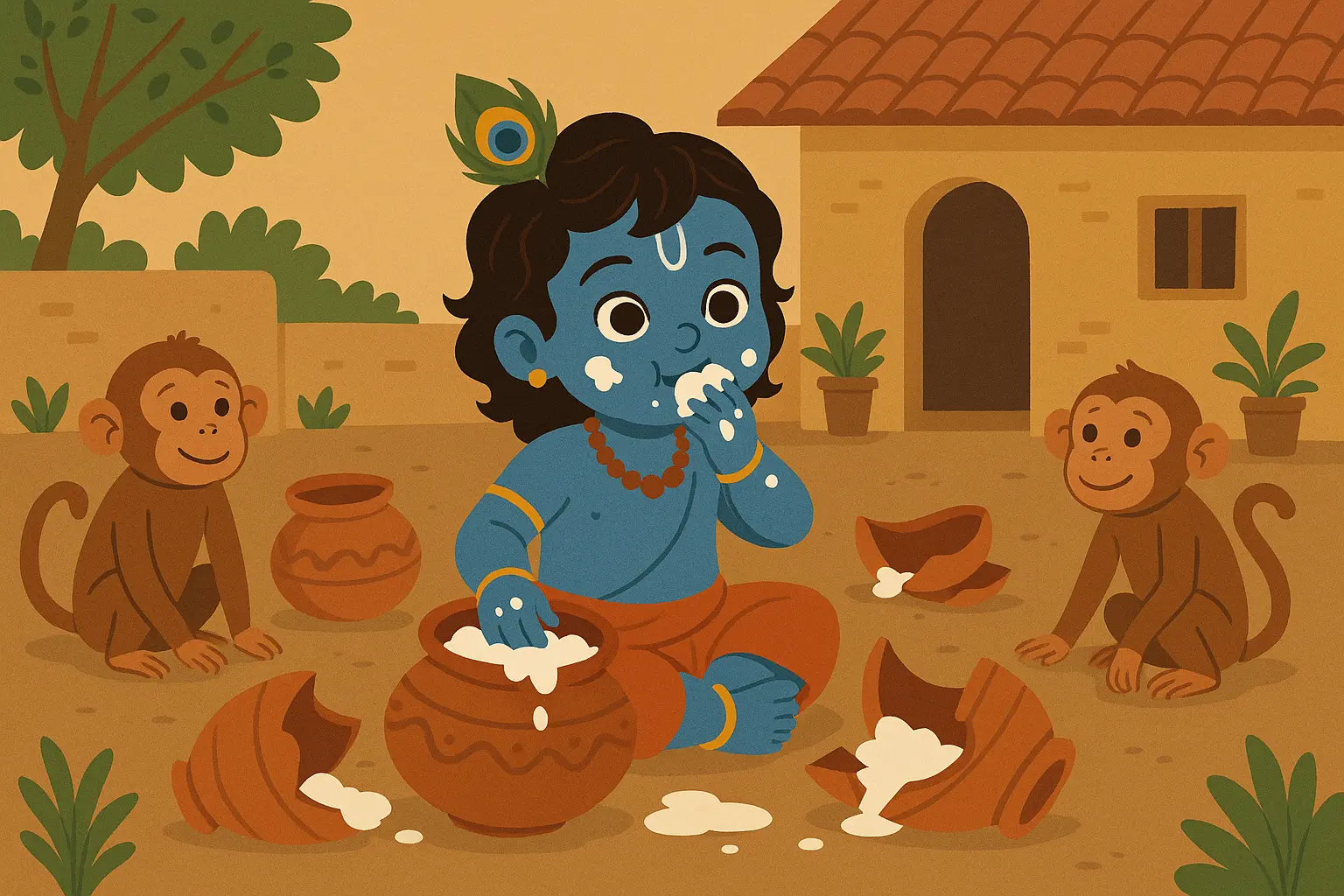
2. Getting Tied Up (And Why It Doesn’t Work)
Krishna’s mom Yashoda finally gets fed up with all the butter stealing and decides to tie him to a heavy wooden grinding wheel as punishment. But here’s the weird thing – no matter how much rope she brings, it’s always exactly two finger-widths too short. She keeps adding more and more rope, but it never quite reaches.
Finally, Krishna lets himself be tied up (because he loves his mom and doesn’t want her to feel bad), but while dragging the wheel around, he manages to knock down two huge trees. Turns out, there were these celestial beings trapped inside the trees, and Krishna freed them.
What Your Kid Learns: Even when we mess up and face consequences, sometimes good things can come out of difficult situations. It also shows that the best discipline comes from love, not anger.
3. The Fruit Lady’s Surprise
Little Krishna watches his dad trade grain for fruit and thinks, “I can do that!” He runs inside, fills his tiny hands with grain, and toddles over to the fruit vendor. Of course, most of the grain falls out of his little fingers before he gets there, so he’s got maybe a handful left.
The sweet old lady sees this determined little kid trying to make an honest trade and gives him the best fruits anyway. When she looks back at her basket later, it’s filled with precious gems.
What Your Kid Learns: Trying to do the right thing matters more than perfect execution. Kindness comes back to you in unexpected ways, and honest effort gets rewarded even when things don’t go perfectly.
4. The Ultimate Hide-and-Seek Champion
During a game of hide-and-seek, Krishna uses his divine powers to appear in multiple places at once. His mom Yashoda is frantically searching for him, asking everyone, “Have you seen Krishna?” One neighbor points toward the well, another swears he just saw him at the marketplace, a third insists he was by the river just a minute ago.
Poor Yashoda is running all over town following these leads, getting more worried by the minute. Finally, she “finds” him sitting innocently in their courtyard, acting like he’s been there the whole time and asking why she looks so stressed out.
What Your Kid Learns: Creative play is wonderful, and the bond between parents and kids is special. It also shows how imagination can transform ordinary games into magical experiences.
5. The Baby Who Ate the Universe
This one’s trippy, but kids love it. Baby Krishna has this habit of eating dirt (like most toddlers do), and his brother keeps tattling to their mom about it. Finally, Yashoda marches over and demands that Krishna open his mouth so she can clean it out.
When he opens up, she sees the entire universe inside his mouth – stars, planets, oceans, mountains, everything. She’s completely overwhelmed and staggers backward. But then Krishna’s divine power makes her forget what she saw, so she can go back to just loving him as her regular little boy instead of being terrified by his cosmic nature.
What Your Kid Learns: There’s always more to people than meets the eye. Everyone has hidden depths and capabilities. It also teaches respect for mystery and the idea that the most amazing things can be hiding in the most ordinary moments.
The Hero Stories (When Your Kid Needs Courage)
6. Lifting a Mountain to Stop a Bully
When Krishna is seven years old, the king of gods, Indra, gets his ego bruised because the villagers stop worshipping him and start appreciating their local mountain instead. So Indra throws a divine tantrum and sends devastating storms to destroy everything.
Seven-year-old Krishna looks at this cosmic bully terrorizing his community and says, “Nope, not happening.” He walks over to Mount Govardhan and lifts the entire mountain on his little finger like an umbrella. For seven straight days, he holds it steady while thousands of people and animals shelter safely underneath.
Finally, Indra realizes he’s being a jerk and stops the storms. Krishna gently sets the mountain back down like nothing happened.
What Your Kid Learns: Stand up to bullies, even when they seem way more powerful than you. Use your abilities to protect others, not to show off. Sometimes doing the right thing means taking on challenges that seem impossible.
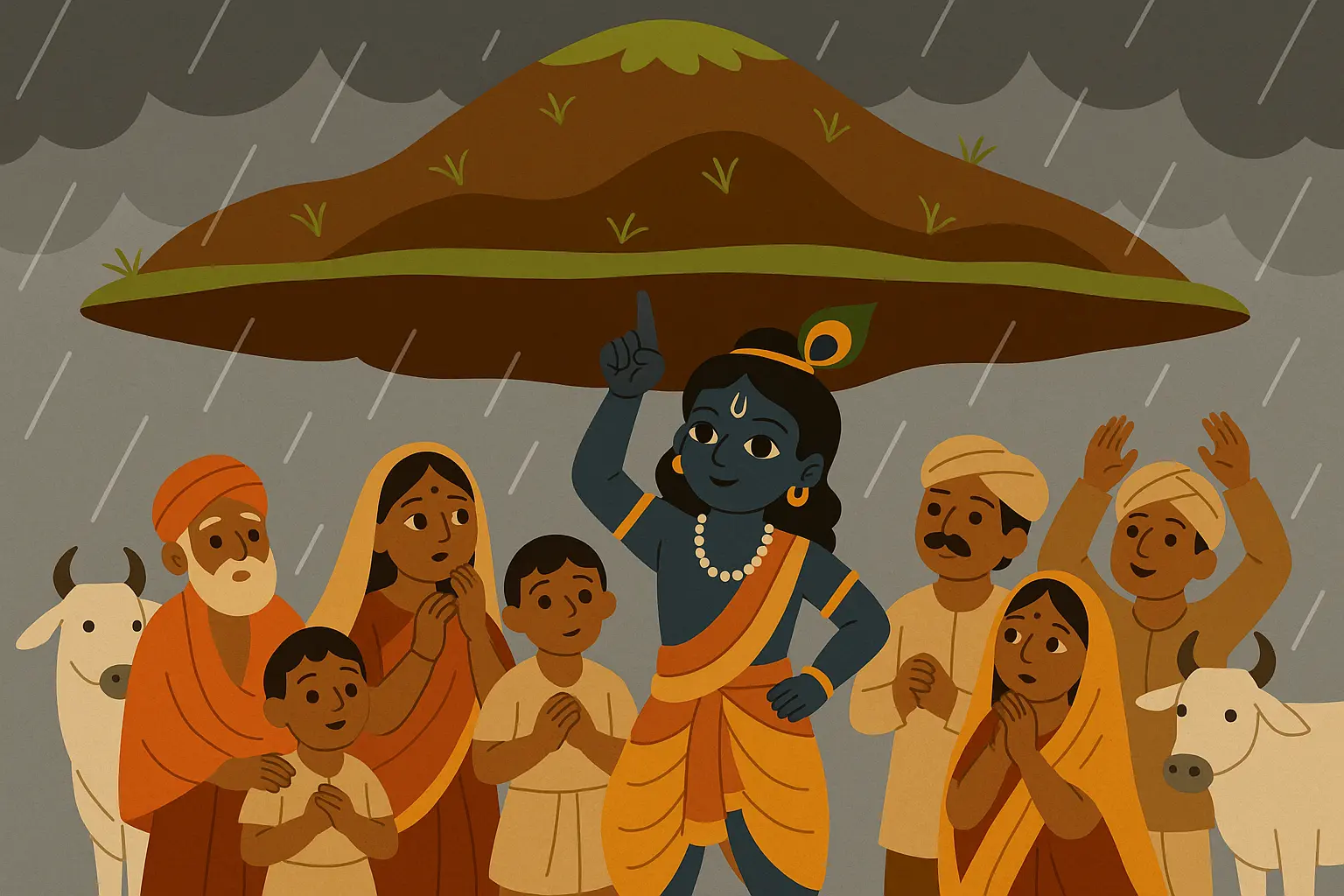
7. Cleaning Up the Neighborhood River
There’s this giant poisonous snake named Kaliya living in the local river, and he’s turned the whole thing toxic. Fish are dying, birds are falling out of the sky after drinking the water, and nobody can use the river anymore.
When Krishna’s ball accidentally falls into the contaminated water during a game, he doesn’t hesitate – he dives right in. The snake attacks him with all hundred and ten of its heads, but Krishna battles it underwater, then jumps onto the snake’s heads and does this cosmic dance that completely subdues the creature.
Instead of killing the snake, Krishna banishes it to the ocean where its poison won’t hurt anyone. The river immediately becomes clean and safe again.
What Your Kid Learns: Sometimes you have to take risks to solve community problems. Environmental cleanup is everyone’s responsibility. You can deal with bullies and troublemakers without destroying them – sometimes they just need to be relocated where they can’t cause harm.
8. Dealing with Stranger Danger
King Kamsa sends this demoness named Putana to eliminate baby Krishna by nursing him with poisoned milk. She disguises herself as a beautiful woman and tricks her way into the house by claiming she wants to bless the famous baby.
When she picks up Krishna to nurse him, he sucks out not just the poisoned milk but her entire life force. As she dies, she transforms back into her giant demon form, but because she came in the role of a mother (even with evil intentions), Krishna grants her salvation.
What Your Kid Learns: Trust your instincts when something feels wrong about an adult. Even people with bad intentions can sometimes be transformed through contact with goodness, but that doesn’t mean you should ignore warning signs or put yourself in danger.
9. When Bad Things Try to Carry You Away
The demon Trinavarta takes the form of a whirlwind and swoops down to carry baby Krishna away while he’s playing. The plan is to lift him high in the air and either drop him or carry him somewhere dangerous.
But as the whirlwind lifts Krishna higher, he becomes impossibly heavy – heavier than mountains, heavier than the earth itself. The demon can’t handle the weight and crashes to the ground, while Krishna lands safely, completely unharmed.
What Your Kid Learns: Even when you feel small or powerless, you have inner strength you might not know about. Good ultimately triumphs over evil, and sometimes the greatest power comes from the most unexpected sources.
10. When Danger Hides in Plain Sight
A demon possesses an ordinary wooden cart positioned above baby Krishna’s cradle, planning to crush him while he sleeps. The cart looks completely normal – just a regular household item that nobody would suspect of being dangerous.
While lying on his back, baby Krishna kicks the cart with his tiny feet. The possessed cart immediately flips over and crashes, destroying the demon inside. The adults think it was just a lucky accident or divine protection, never realizing their baby just defeated a powerful enemy.
What Your Kid Learns: Dangers can hide in familiar forms, so stay alert and trust your instincts. Protection often comes in unexpected ways. Don’t underestimate your own capabilities – you might be stronger than you think.
The Friendship Stories (For Social Skills)
11. Krishna and His Poor Friend Sudama
This is the friendship story that makes everyone cry. Krishna and Sudama are best friends as kids, but as adults, their lives go in completely different directions. Krishna becomes a king while Sudama becomes a poor teacher struggling to feed his family.
When Sudama’s family is facing serious hardship, his wife encourages him to visit Krishna for help, even though Sudama feels embarrassed about his poverty. He brings only a handful of beaten rice – literally the best his family can afford.
When Sudama arrives at Krishna’s palace, Krishna doesn’t care about the fancy surroundings or royal protocol. He personally washes his friend’s feet, shares his simple food with genuine joy, and treats him like the most important person in the world.
Sudama feels too shy to actually ask for help, but Krishna understands anyway. After Sudama leaves, Krishna secretly transforms his humble home into a beautiful place where his family will never want for anything again.
What Your Kid Learns: True friendship doesn’t care about money or status. Good friends help each other without being asked. The best relationships are built on shared memories and genuine care, not on what people can give each other.
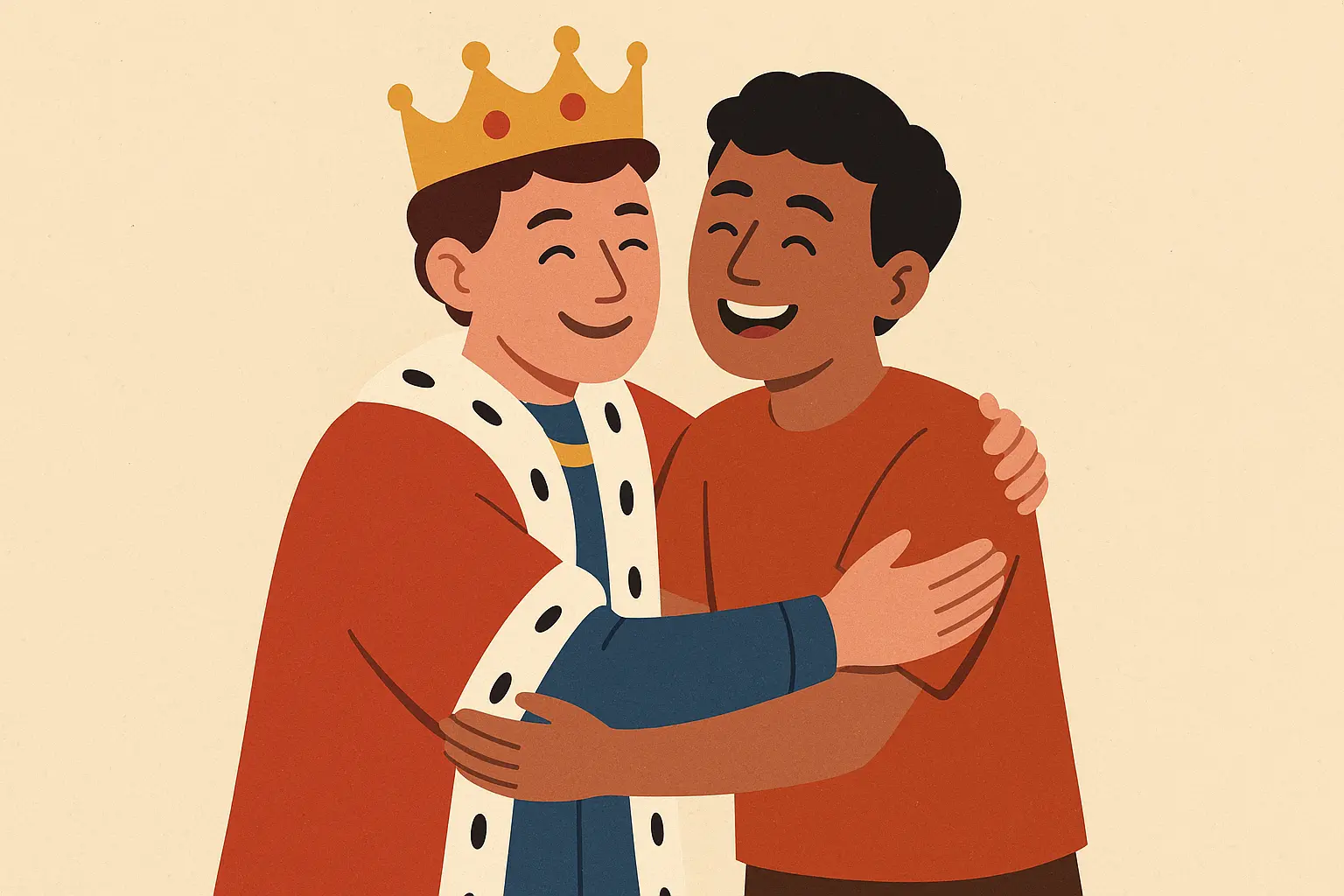
12. The Village Women Who Found Joy
The women of Vrindavan develop such pure love for Krishna that when they hear his flute, they drop everything to spend time with him. This isn’t romantic – it’s more like how kids abandon their chores when they hear the ice cream truck.
At first, their families complain about this behavior. But then something interesting happens – the women become so filled with joy and peace that they actually become better at everything else. They’re happier wives, more patient mothers, and kinder neighbors.
Their joy becomes contagious, spreading throughout the entire community and making everyone’s life better.
What Your Kid Learns: When we’re genuinely happy, it makes everyone around us happier too. Following what truly fulfills you can actually improve all your other relationships and responsibilities, not hurt them.
13. Playing Fair with Everyone
Krishna spends his days playing with kids from all different backgrounds – rich families, poor families, farmers, merchants, doesn’t matter. During games, he makes sure everyone gets equal turns, rotates leadership roles, and ensures no one feels left out or less important.
When they play hide-and-seek, everyone gets to be “it.” When they share snacks, Krishna makes sure the portions are fair. His natural leadership style creates an environment where every child feels valued and included.
The other kids learn from Krishna’s example and start treating each other the same way. Their play group becomes a model of equality and friendship that influences the entire village.
What Your Kid Learns: Good leaders treat everyone as equals regardless of their background. Include everyone in your games and activities. Look beyond surface differences and value what each person brings to the group.
14. The Magical Dance Party
On moonlit nights, Krishna plays his flute and calls the village girls to dance with him in forest clearings. Through his divine power, he multiplies himself so each girl feels like she’s dancing personally with Krishna – everyone gets his complete attention while also being part of something bigger and more beautiful.
The circular dance represents perfect harmony where everyone feels special individually while creating something amazing together. Each dancer feels energized rather than tired, and the experience brings pure joy to everyone involved.
What Your Kid Learns: Great leaders make everyone feel special and individually valued while creating group experiences where everyone feels important and included. You can give personal attention to each friend while still building strong group activities.
The Deep Lessons (When They’re Ready for Big Ideas)
Just as our story theme examples demonstrate how universal themes can be woven throughout narratives, Krishna’s teaching stories embed profound wisdom within engaging plots.
15. The Battlefield Conversation (Yes, It’s Actually Relatable)
I know, I know – the Bhagavad Gita sounds intimidating. But here’s the thing: it’s basically about a guy having a panic attack before a big challenge, and his friend helping him figure out what to do. Sound familiar? Every kid faces this.
Prince Arjuna is supposed to fight in this huge battle, but when he gets there and sees his relatives, teachers, and friends on both sides, he completely freaks out. He throws down his weapons and tells Krishna he’d rather die than hurt people he loves.
Krishna, who’s driving his chariot, basically gives him a pep talk about doing your duty even when it’s hard, focusing on effort rather than results, and understanding that some challenges are bigger than our personal comfort.
What Your Kid Learns: Do your best in school, sports, and other activities without obsessing over grades or winning. Focus on effort and doing the right thing rather than just achieving specific results. Sometimes you have to do difficult things because they’re the right things to do.
16. Choosing Right Over Easy
Throughout his life, Krishna consistently chooses to do what’s right rather than what’s convenient, even when the right choice leads to difficult consequences. He shows that real integrity isn’t about following rules blindly, but about understanding why ethical behavior matters.
Sometimes doing the right thing means breaking conventional rules to serve a higher purpose. Other times it means following difficult paths that others try to avoid. Krishna teaches that good choices require wisdom, courage, and willingness to accept responsibility.
What Your Kid Learns: Choose honesty and integrity even when it’s challenging. Doing the right thing is more important than avoiding temporary trouble. The best choices aren’t always the easiest ones, and that’s okay.
17. Learning from Everything Around You
Krishna uses simple stories and examples from nature to teach complex ideas, making profound wisdom accessible to people of all ages. When teaching about patience, he points to how trees bear fruit only in their proper season. When explaining service, he shows how rivers flow continuously to help all life without expecting anything back.
His teaching method makes abstract concepts concrete and memorable. Krishna demonstrates that the deepest truths often hide in the simplest experiences – you just have to pay attention.
What Your Kid Learns: You can learn important lessons from everyday experiences if you pay attention. Look for wisdom in nature and daily activities. When explaining difficult concepts to others, use familiar examples that make sense to them.
18. Appreciating What Actually Helps You
The villagers traditionally perform elaborate rituals to appease Indra, hoping for good rains and protection. Young Krishna questions this, asking why they worship a distant god when Mount Govardhan provides everything they actually need – grass for cattle, herbs for medicine, water from streams.
Krishna suggests they appreciate the hill instead, offering simple flowers, fruits, and genuine gratitude for what directly helps their daily lives. When Indra gets angry and sends storms, Krishna protects everyone by lifting the hill, proving that sincere appreciation for what actually helps us is more powerful than empty gestures.
What Your Kid Learns: Appreciate and care for your immediate environment – your school, neighborhood, and natural surroundings. Genuine gratitude and taking care of what helps you is more valuable than empty gestures or rituals you don’t understand.
19. Staying Humble No Matter What
Despite having unlimited divine powers, Krishna always remains humble, playing with ordinary children and helping with everyday tasks like herding cattle. He never uses his abilities to show off or make others feel inferior – instead, he uses his gifts to serve and protect others.
Krishna demonstrates that truly powerful people don’t need to constantly prove their strength or superiority. Real greatness shows itself through kindness and making others feel valued, not through displays of dominance.
What Your Kid Learns: Truly great people are humble and helpful regardless of their abilities or achievements. The best way to use your talents and skills is to help others. Real confidence doesn’t require putting others down or constantly seeking attention.
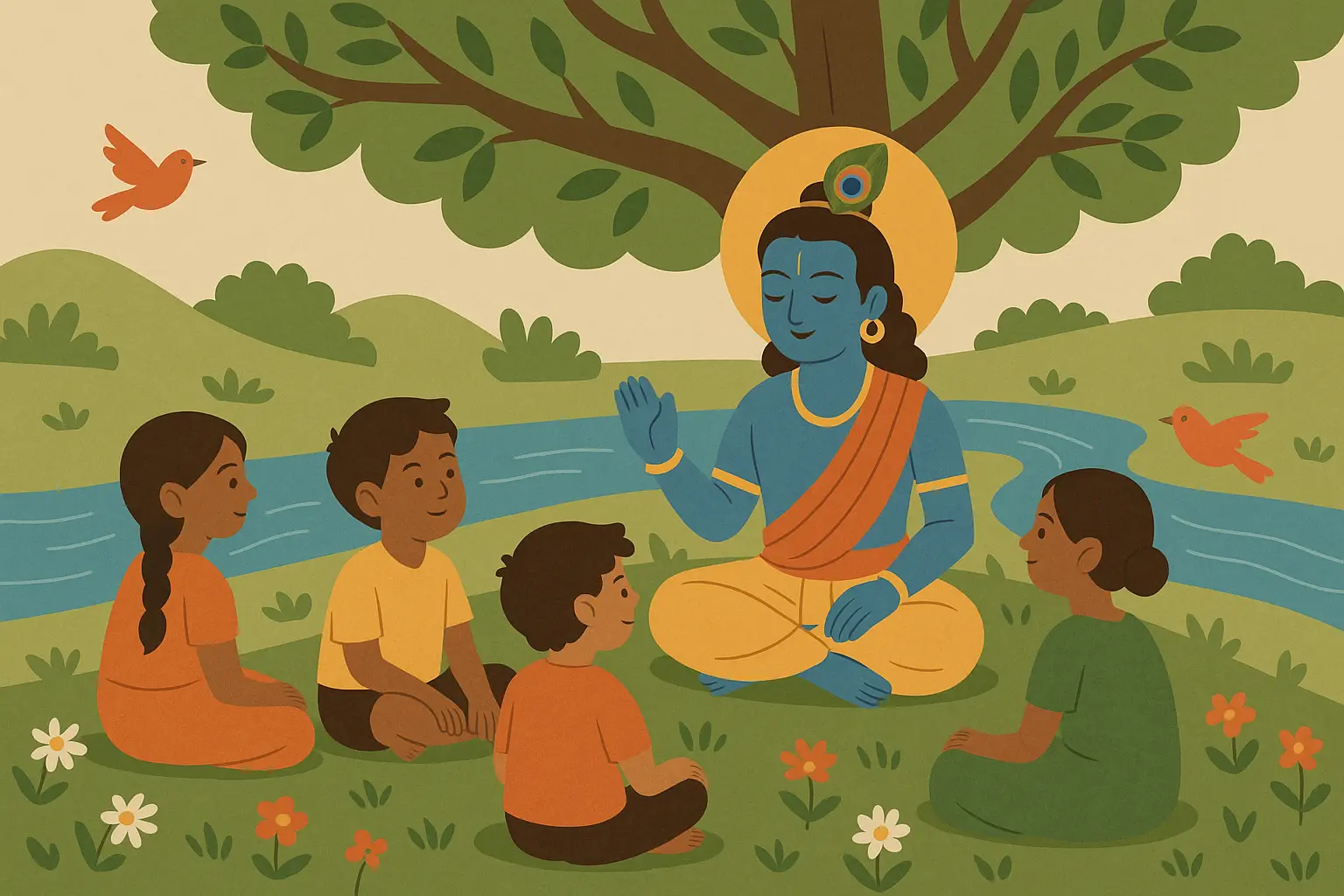
The Magic and Wonder Stories
20. The Never-Ending Lunch
During a forest picnic, Krishna and his friends get hungry after playing all morning, but they’ve only brought a small amount of food to share. Instead of letting anyone go hungry, Krishna takes their meager meal and somehow multiplies it so there’s plenty for everyone.
Each friend gets exactly what they want most – some want sweet rice pudding, others prefer savory dishes, still others crave fresh fruits. Everyone is completely satisfied, and the food keeps appearing whenever someone wants more.
What Your Kid Learns: When we share what we have with others, there’s often enough for everyone. Consider what others want and need, not just yourself. Cooperation can create abundance from scarcity.
21. Getting Extra Time When You Really Need It
When a devoted follower faces an impossible deadline to complete an important promise, Krishna stops the sun from setting, giving the person extra hours to fulfill their commitment. The sun stays motionless in the sky until the task is complete, then continues its normal course.
What Your Kid Learns: Help your friends meet important deadlines when you can. When we make sincere promises, help often comes from unexpected places. It’s important to keep your word even when it’s difficult.
22. The Mind-Blowing Vision
To prove his divine identity to those who doubt him, Krishna reveals his cosmic form – appearing with countless heads, arms, and eyes, containing the entire universe within himself. The vision is so overwhelming that even his closest friends beg him to return to his familiar human form, which he does with a gentle smile.
What Your Kid Learns: Everyone has hidden depths and capabilities you might not see on the surface. There’s always more to learn about people. The most powerful people often choose to appear ordinary and approachable.
23. The Healing Touch
Krishna’s gentle touch brings comfort to the sick and healing to those who suffer. When villagers bring their problems to him, he doesn’t perform dramatic rituals – he simply places his hands on them with genuine love and concern.
The healing power comes from Krishna’s complete attention and care for each person’s wellbeing. His touch carries pure compassion, which has the power to heal both physical ailments and emotional wounds.
What Your Kid Learns: Gentle, caring attention can help heal both physical and emotional hurts. Sometimes the best medicine is simply showing someone you care about them. Compassion and genuine concern for others have real healing power.
The Character Building Stories
24. When to Tell the Truth (And When It’s Okay to Be Playful)
When accused of childhood mischief, Krishna sometimes playfully denies his actions with a mischievous smile, but when serious moral issues come up, he always speaks truth regardless of consequences. His life shows the difference between harmless playfulness and serious dishonesty.
Krishna teaches that while innocent fibbing during games might be harmless fun, lying about important matters damages trust and relationships. He shows when flexibility is okay and when absolute honesty becomes crucial.
What Your Kid Learns: There’s a difference between harmless playfulness and serious dishonesty. While small fibs during games might be okay, lying about important things hurts relationships and breaks trust with people who care about you.
My friend Jen had a student named Alex who was going through a lying phase about homework. After she shared Krishna’s truth-telling story, explaining how Krishna knew the difference between playful mischief and serious dishonesty, something clicked. The next day, Alex voluntarily admitted he hadn’t finished his assignment and asked for help managing his time better.
25. Being Kind to Everyone
Krishna shows equal love and care for humans, animals, and even former enemies who seek redemption. He plays gently with calves, protects cows from harsh weather, and offers salvation even to demons who initially tried to harm him if they show genuine remorse.
His universal compassion demonstrates that divine love excludes no one and that every being deserves kindness and second chances. Krishna treats the smallest creatures with the same respect he shows great kings, recognizing inherent value in all life.
What Your Kid Learns: Be kind to animals, show compassion to those who are different, and give second chances to people who make mistakes. Everyone deserves kindness, and treating all beings with respect creates a better world for everyone.
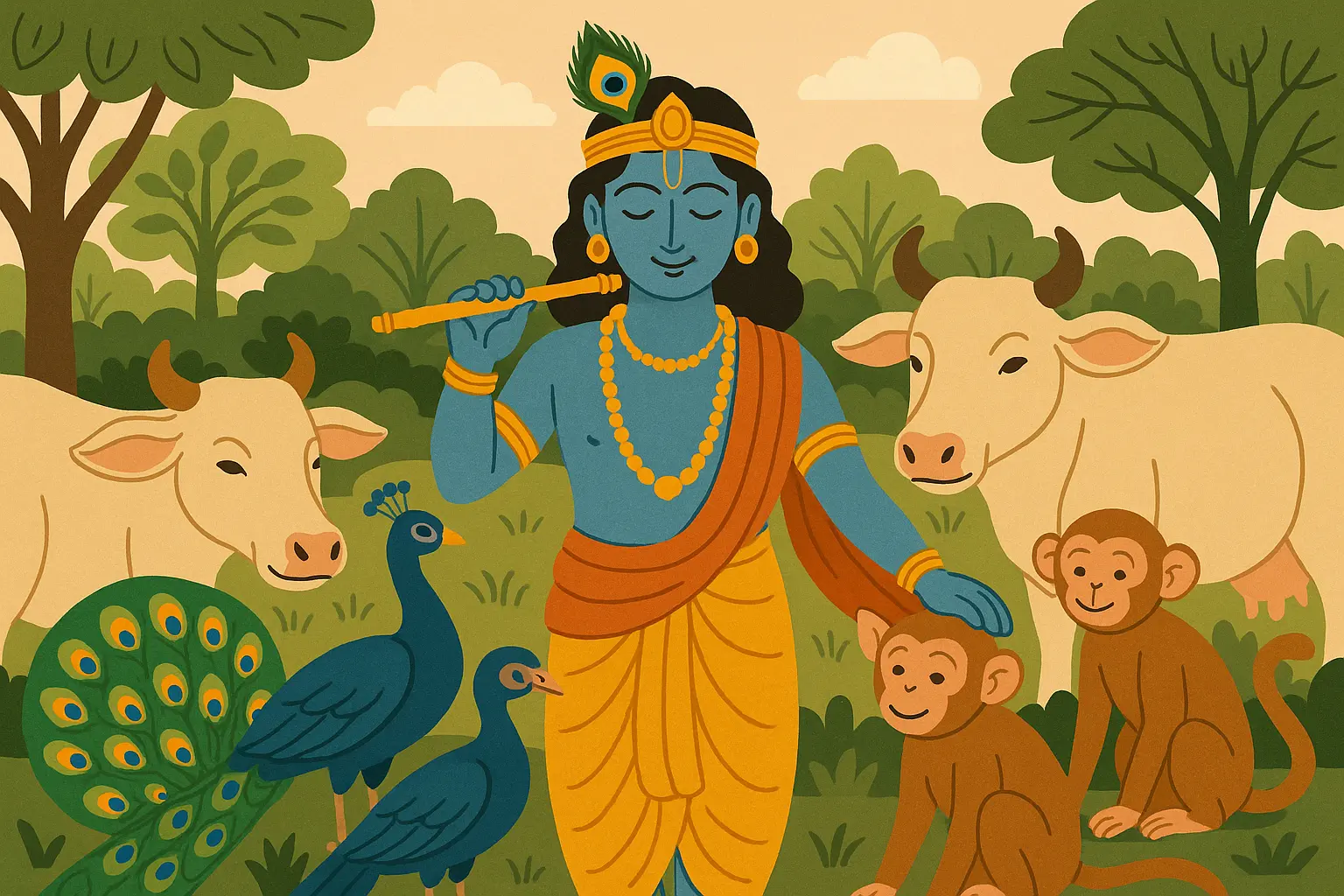
Why These Stories Actually Work with Modern Kids
When I’m picking which story to tell, I ask myself three simple questions: Will my kid actually sit still for this? Does it connect to something happening in their life right now? And honestly – do I understand it well enough to answer their inevitable “but why” questions?
The stories I’ve shared here pass all three tests. They’re engaging enough to hold attention, relevant to real childhood challenges, and straightforward enough that you don’t need a theology degree to explain them.
For Younger Kids (4-7): Stories 1-5 and 8-10 work perfectly because they use simple language and clear lessons. The butter thief adventures and basic hero stories present straightforward cause-and-effect that young minds easily grasp.
For Older Kids (8-12): Stories 6-7, 11, 15, and 18-25 challenge them with deeper concepts and complex character development. These tales require the kind of abstract thinking about duty, environmental responsibility, and moral reasoning that matches their developmental stage.
For All Ages: Stories 12-14 and 16-17 work across age groups because kids can understand them at different levels. Younger children enjoy the surface adventure while older kids appreciate the deeper relationship dynamics.
The beauty is in their authenticity. Each story preserves essential cultural elements while making them accessible to modern audiences. You get clear explanations of unfamiliar concepts without losing the spiritual depth that makes these tales special.
Making Ancient Stories Feel Fresh
Look, I get it. You’re competing with YouTube and video games here. Sometimes the old “sit in a circle and listen” approach just doesn’t cut it anymore. And that’s okay!
I’ve seen parents stress about “doing it right” or worry they don’t know enough about Hindu culture to tell these stories. Here’s what I tell them: start messy. Use your phone to look up pronunciations. Let your kids ask weird questions. Make it a conversation, not a performance.

Traditional storytelling approaches, similar to those found in our folktale story examples, can be enhanced with modern techniques while maintaining their essential wisdom.
This is where modern tools can help. AI story generators can help you adapt complex cultural concepts into language your specific kid will understand while keeping the spiritual authenticity intact. They can help explain cultural contexts in ways that make sense to modern children without losing essential meaning.
Tools like our kids story generator can help you create personalized versions of Krishna tales that match your child’s interests and reading level.
When traditional approaches feel outdated, these tools help create fresh ways to tell ancient stories that capture young imaginations while preserving the profound wisdom within. Whether you’re struggling with how to start a childhood adventure tale, developing authentic dialogue, or creating interactive elements that bring these stories to life for digital-native kids, modern storytelling assistance provides the creative partnership you need.
Every child connects differently based on their interests, reading level, and background. Personalized approaches help adapt these timeless Krishna tales to match individual children’s needs, ensuring the wisdom reaches young hearts in the most effective way possible.
Here’s What I’ve Learned
After years of telling these stories to kids, here’s what I know for sure: they work because they’re honest about how hard it can be to do the right thing. Krishna isn’t some perfect kid who never messes up – he’s mischievous and real and sometimes gets in trouble. Kids see themselves in that.
These 25 Krishna stories aren’t just entertainment – they’re tools for raising good humans that have worked for thousands of years. Each tale combines adventure, wisdom, and moral guidance in ways that speak directly to young hearts while building the ethical foundation children need for life success.
The magic is that these stories grow with your kids. A four-year-old loves the butter-stealing adventures for their humor and mischief, then returns to the same stories at age ten to discover deeper lessons about consequences, sharing, and family relationships. This layered wisdom makes them invaluable resources for ongoing character development.
Just as our collection of short story examples demonstrates the power of narrative to convey profound truths, these Krishna stories for kids offer timeless wisdom wrapped in engaging adventures that children naturally love.
Modern parents can use these stories to address contemporary challenges while connecting children to rich cultural traditions. Environmental stewardship, anti-bullying messages, inclusive friendship, and ethical decision-making remain as relevant today as they were in ancient times. The universal values embedded in these tales transcend cultural boundaries while offering authentic spiritual wisdom.
Start with one story tonight. Maybe the butter thief one – kids love a good heist story. See what questions come up. Don’t worry about explaining everything perfectly. The magic is in the conversation that happens after.
The most powerful thing about Krishna stories isn’t their entertainment value or even their moral instruction – it’s their ability to inspire children to become their best selves. When kids see Krishna choosing courage over comfort, friendship over status, and service over self-interest, they discover models for their own character development that will serve them throughout their lives.



Add comment